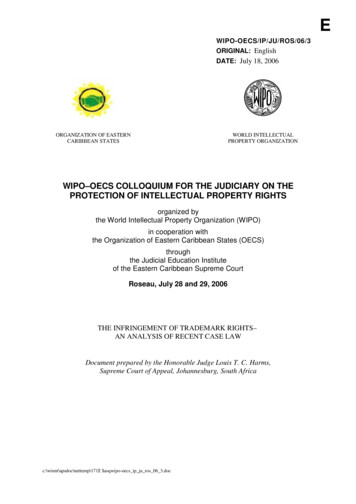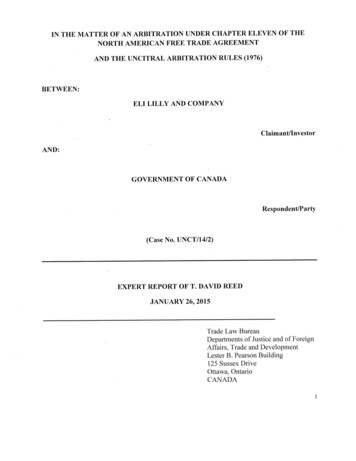
Transcription
EWIPO-OECS/IP/JU/ROS/06/3ORIGINAL: EnglishDATE: July 18, 2006ORGANIZATION OF EASTERNCARIBBEAN STATESWORLD INTELLECTUALPROPERTY ORGANIZATIONWIPO–OECS COLLOQUIUM FOR THE JUDICIARY ON THEPROTECTION OF INTELLECTUAL PROPERTY RIGHTSorganized bythe World Intellectual Property Organization (WIPO)in cooperation withthe Organization of Eastern Caribbean States (OECS)throughthe Judicial Education Instituteof the Eastern Caribbean Supreme CourtRoseau, July 28 and 29, 2006THE INFRINGEMENT OF TRADEMARK RIGHTS–AN ANALYSIS OF RECENT CASE LAWDocument prepared by the Honorable Judge Louis T. C. Harms,Supreme Court of Appeal, Johannesburg, South Africac:\winnt\apsdoc\nettemp\1712\ asqwipo-oecs ip ju ros 06 3.doc
WIPO-OECS/IP/JU/ROS/06/3page 2Slide 1Trademarks:withcase studiesHon. LTC Harms SCSupreme Court of AppealSouth AfricaSlide 2How to distinguish? Slide 3Function of trademarks To distinguish the goods or servicesfrom those of others, i.e., to indicatetheir origin (badge of origin). Advertising function. Guarantee of quality.
WIPO-OECS/IP/JU/ROS/06/3page 3Slide 4What is a trademark? Any sign, or combination of signs, capable ofdistinguishing the goods or services of oneundertaking from those of other undertakings Sign must be capable of being representedgraphically. ‘To be really distinctive of a person’s goods[or services a trade mark] must generallyspeaking be incapable of application to thegoods [or services] of anyone else.’Slide 5World Football 2006 The court in Karlsruhe rejected FIFA'sattempt to secure a tm on the Germanlanguage slogan ‘Fussball WM 2006’, whichmeans Football World Cup 2006. The court based its decision on the fact that‘Fussball WM 2006’ referred to a sports eventand not to a body like FIFA. The mark is descriptive, not distinctive.Slide 6Types of trademarks Devices or logos.Names: FORDWords: APPLELetters: BMWNumerals: 4711shapes, configurations, patterns, ornamentations,colour or container for goods.
WIPO-OECS/IP/JU/ROS/06/3page 4Slide 7Trademarks are mainly of 4 varieties ‘Generic’: it may refer to the genus of which theproduct may be a species. ‘Descriptive’: it may describe the nature or type ofgoods to which they are applied. ‘Suggestive’, which involves imagination, thought andperception to reach a conclusion to the nature of thegoods. ‘Arbitrary’ or fanciful, which does not have anyconnection to the nature or type of the goods.PLAYBOY ENTERPRISES INC v BHARAT MALIK (India)Slide 8Logos A logo is a design which becomes a markwhen used in close association with thegoods or services being marketed. The logo mark does not need to be elaborate;it need only distinguish. Pictures or drawings of a character or sceneare often used as trademarks or servicemarks.Slide 9
WIPO-OECS/IP/JU/ROS/06/3page 5Slide 10Shapes A product or container shapecan also serve a sourceidentifying function andtherefore can be anenforceable trademark. They may also be subject to adesign registration (but whichis limited in time).Slide 11Shapes: pharmaceuticals The test is whether B used or proposedto use the shape of the tablet ‘for thepurpose of distinguishing’ it from tabletssold by others or whether the function of the shape is todistinguish these tablets from )20022002Slide 12Bocksbeutel‘According to public perception containers andshapes generally do not serve as sourceidentifiers. Containers are usually perceivedto be functional and, if not run of the mill, tobe decorative and not badges of origin.’ ‘Just because a shape is unusual for the kindof goods concerned, the public will [not]automatically take it as denoting trade origin,as being the badge of the maker.’BergkelderBergkelder(SA)(SA)20062006
WIPO-OECS/IP/JU/ROS/06/3page 6Slide 13Doctrine of functionality (Kirkby) A mark which goes beyond distinguishing the waresof its owner to the functional structure of the waresthemselves is transgressing the legitimate bounds ofa trademark. Doctrine reflects the purpose of a trademark. A purely functional design cannot be the basis of atrademark and trademark law should not be used toperpetuate monopoly rights enjoyed undernow- expired patents. Lego blocks are not trademarks.Slide 14Slogans Slogans from advertising campaigns are alsoused as trademarks:–‘It’s finger lickin good’. But: ‘the average consumers are not in thehabit of making assumptions about the originof products on the basis of slogans.’Slide 15McDonalds McFries McChicken McNuggets MacTea, MacChocolate and MacNoodles –Singapore. No confusion. McBagel, McPretzel and McSalad – USA. Yes ‘McMint, McVeg – Australia. No confusion. McSALAD and McFRESH - Australia. Yes.
WIPO-OECS/IP/JU/ROS/06/3page 7Slide 16Embellishment v trademarksAdidas Fitnessworld (2 stripes) ECJ Adidas (4) SAfr Adidas (4) DenmarkSlide 17In determining whether a mark isdistinctive, the courts group marks intofour categories, based on the relationshipbetween the mark and the underlyingproduct:(1) arbitrary or fanciful: Exxon, Kodak(2) suggestive: Coppertone(3) descriptive: Holiday Inn or(4) generic: Apple for apples.Slide 18Pre-conditions RegistrationIn classesUse/to be usedCourse of tradeGoods or services: marks that are used toidentify services (e.g. ‘BA’ or ‘Speedy DryCleaners’) are called service marks, althoughthey are treated the same as othertrademarks.
WIPO-OECS/IP/JU/ROS/06/3page 8Slide 19Exceptions: fair use: Trips art 17 Countries may provide limitedexceptions to the rights conferred by atrademark, such as fair use of descriptive terms, provided that such exceptions takeaccount of the legitimate interests ofthe owner of the trademark AND ofthird parties.Slide 20DRISTAN Trade Mark (India) A trademark is meant to distinguish the goods madeby one person from those made by another. A trademark therefore cannot exist in vacuo. It can only exist in connection with the goods [orservices] in relation to which it is used or intended tobe used. Its object is to indicate a connection in the course oftrade between the goods [or services] and someperson having the right to use the mark either withor without any indication of the identity of thatperson.Slide 21Infringement is usually intentionalSingaporeSingapore
WIPO-OECS/IP/JU/ROS/06/3page 9Slide 22Imitation need not be infringementLikelihood of association withoutlikelihood of confusion is not enough Colt 45 v Stallion 54: for beer.SASABreweriesBreweriesSlide 23DisclaimersSlide 24USE OF ‘IDENTICAL’ MARKS The use of an identical mark not,necessarily, infringement ofregistered trademark. For infringement, the marks mustbe used on identical or similar goodsor services
WIPO-OECS/IP/JU/ROS/06/3page 10Slide 25Identical marks ‘Max’ formagazines. ‘Infringement’: ‘Max’used on boots. Judgment: noconfusion: goods notsimilar.Slide 26What is ‘identical’? ‘Power’ Infringing mark: ‘Power House’or ‘Powerhouse’. Goods: Used on clothing. No infringement.Slide 27Added matterIdentify the defendant’s indication oforigin: ‘Polo’ Polo Club 10 Royal Berkshire Polo Club
WIPO-OECS/IP/JU/ROS/06/3page 11Slide 28COUNTERFEITING ANDINFRINGEMENTSlide 29Use of similar marks Similar trademarkused in relation to goods or servicesidentical with orsimilar to those in respect of which theplaintiff’s mark is registered infringementSlide 30Prozac and Herbozac Registered trademark:PROZAC, a prescriptiondrug for clinicaldepression. Infringing mark:HERBOZAC for herbalmood elevators. Infringement found.USAUSA
WIPO-OECS/IP/JU/ROS/06/3page 12Slide 31Factors to determine consumerconfusion The similarity between the marks inappearance and suggestion, The similarity of the products, The area and manner of concurrent use ofthe products,Slide 32Factors to determine consumerconfusion The degree of care likely to be exercised byconsumers, The strength of the complainant’s mark, Evidence of actual confusion, and The defendant’s intent (or lack thereof) topalm off its product as that of another.Slide 33CANNON & CANON CANON, registered in respect of videorecorders. CANNON for films recorded onvideotape cassettes Public perception: do ‘films recorded onvideo tape cassettes’ and videorecorders come from the sameenterprise?ECJECJ
WIPO-OECS/IP/JU/ROS/06/3page 13Slide 34Similar marks:Test A likelihood of confusion required. Must be determined globally. Global appreciation of:–––visual,aural orconceptual similarity of the marks,Slide 35Global appreciationMust be based on the overall impressiongiven by the marks,bearing in mind, in particular, theirdistinctive anddominant components.Slide 36Alternative test for similarity The respective uses of the goods or services; The respective users; The physical nature of the goods or acts ofservice; The respective trade channels; Are the goods or services competitive. Similarity does not equal confusion!!!
WIPO-OECS/IP/JU/ROS/06/3page 14Slide 37Julius Sämann Ltd v Tetrosyl Ltd[2006] EWHC 529 Deodorants/air fresheners Slide 38‘BARILLA’ Goods: Pasta.Likelihood of confusion found.Slide 39‘PPS’ Registered trademark: leftInfringement: right.Class: Insurance business.
WIPO-OECS/IP/JU/ROS/06/3page 15Slide 40Puma and Sabel for shoes:conceptual similarity is notenough.Slide 41Dairy Belle vsCowbellSlide 42Local culture: ALBEX ALL BLAXThe question whether two marks are likely to give rise toconfusion or not is a question of first impression.It is for the court to decide that question.English cases proceeding on the English way of pronouncing anEnglish word by Englishmen, which is not always the same, whichmay not be of much assistance in our country in decidingquestions of phonetic similarity.The word is an English word which to the mass of the Indianpeople is a foreign word.CORN PRODUCTS REFINING CO v SHANGRILA FOOD PRODUCTS (India)
WIPO-OECS/IP/JU/ROS/06/3page 16Slide 43Fair and normal use:TREAT Slide 44‘Treat’ and ‘Toffee Treat’ TREAT –Goods: Dessert sauces and syrups. Accused mark: TOFFEE TREAT–Goods: Sweet spread (like jams). Correct questions:––is there similarity of goods or services?if so, is there a likelihood of confusion? Goods not sufficiently similar.Slide 45Well-known marksWellknown markRegisteredUnregistered
WIPO-OECS/IP/JU/ROS/06/3page 17Slide 46Protection of unregistered marks Basic rules:Registration confers trademark rights.– Trademark rights are territorial.– Exception: Well-known (foreign)trademarks are entitled to protectionwithout registration.Slide 47Art 6bis of Paris Convention The trademark owner of anothercountry whose trademark, even thoughnot registered within the localjurisdiction, is well known locally, mayobject to the registration or may claimcancellation of a trademark thatconstitutes a reproduction, an imitation,or a translation, liable to createconfusion of his trademark.Slide 48Unfair competition compared
WIPO-OECS/IP/JU/ROS/06/3page 18Slide 49VICTORIA’S SECRETStrade mark is a purely territorial conceptthere is nothing to prevent a person fromasserting a proprietary right in a trade markin relation to whichno one else hasin the same territoryasserted a similar rightSlide 50PROTECTION OF WELL-KNOWNTRADEMARKSSlide 51Requirements for protection Owner must have a real and effective industrialor commercial establishment in a conventioncountry. A sector of the population must be ‘interested inthe goods or services to which the mark relates’. The mark must be well known within the localjurisdiction as a trademark belonging to anenterprise with a base in another country. A substantial number must have the knowledge.
WIPO-OECS/IP/JU/ROS/06/3page 19Slide 52Known to a sector of public A mark is well known in the Republic ifit is well known to persons interested inthe goods or services to which the markrelates.Slide 53The Gap ‘The objectionable trademark has to be ‘areproduction, imitation or translation of the wellknown trademark’ of a ‘qualified’ party. Unless the ‘foreign’ trademark was well knownat the time when the local enterprise reproduced,imitated or translated it, the foreign trademark isin the light of the principle of territoriality notentitled to art. 6bis protection.Slide 54Dilution of well-known marks
WIPO-OECS/IP/JU/ROS/06/3page 20Slide 55Mattel v. 3894207 Canada Inc 2006 SCC 22 Some [not all] trade marks are so wellknown that their use on any wares of anykind would cause the public to believe thatthe owner was in some way responsible forthe wares to which the use of the mark hasbeen extended. Depends on the circumstances. Not applicable: Barbie dolls and restaurants.Slide 56Veuve Clicquot v. Boutiques Cliquot Women’s wear shops use the trade- name Cliquot. The question whether there exists a likelihood ofconfusion is largely one of fact. The fact of being famous or well known does notby itself provide absolute protection for atrade- mark. It is one factor which must be assessed togetherwith all the others.Slide 57Get-up vs trade mark: Romany Creams
WIPO-OECS/IP/JU/ROS/06/3page 21Slide 58Unfair competition/Passing-off(no registration)Slide 59Get-up: the rule The infringing mark must be comparedwith the registered mark. The get-up used by the plaintiff must beignored. The likelihood of deception or confusionmust be attributable to the resemblance(or otherwise) of the marks themselvesand not to extraneous matter.Slide 60[End of Document]
Triomed (SA) 2002 Beecham v Triomed (SA) 2002 Slide 12 Bocksbeutel 'According to public perception containers and shapes generally do not serve as source identifiers. Containers are usually perceived to be functional and, if not run of the mill, to be decorative and not badges of origin.' 'Just because a shape is unusual for the kind










